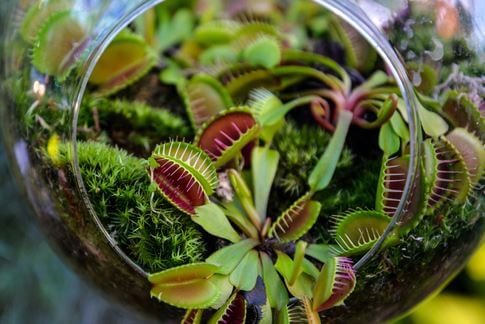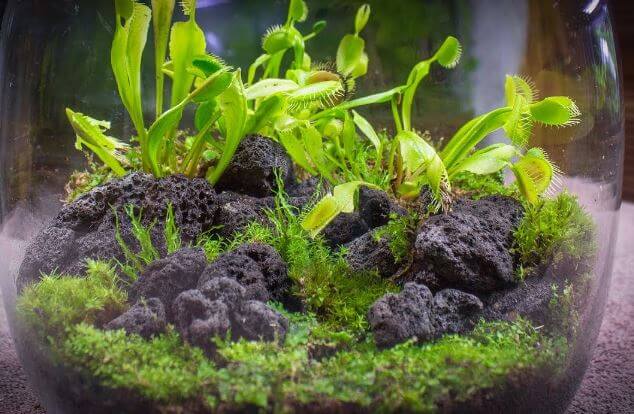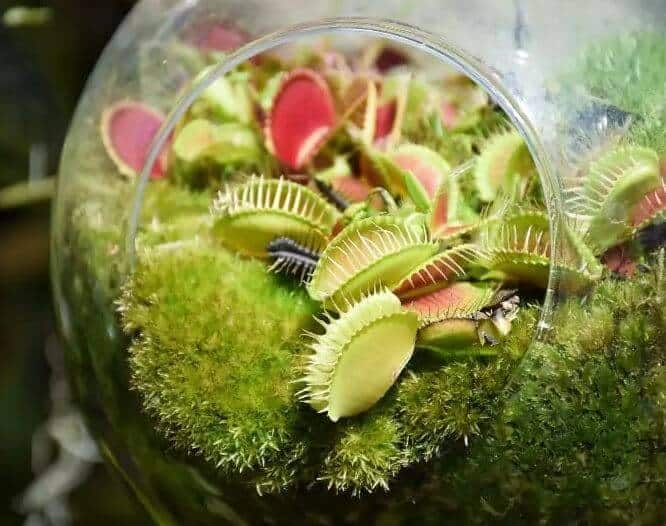Last Updated on March 6, 2023 by a Friendly Gardener
Venus Fly Traps are certainly among the most fascinating houseplants found in indoor gardens. Yet all that uniqueness can offer some challenges when it comes to proper caring. If you are a terrarium aficionado and want to include one of these beauties, the Venus Fly Trap can prove to be even more challenging.
Fly Traps are high-maintenance carnivorous plants because they have specific needs for soil, light, water, humidity, and temperature. It’s sufficient to think about where the Fly Trap’s native habitat is found. It is endemic naturally only in the states of North and South Carolina and naturally grow only near Cape Fear within a 100-mile radius, so the characteristics of their environment are very specific. Still, if your goal is to cultivate one or more of these plants in a terrarium, it can be done with a bit of extra care.
Creating and Managing a Venus Fly Trap Terrarium

Soil
The Fly Trap developed its nature as a carnivorous plant because it grows in bogs where the soil is very poor or devoid of nutrients. Its natural environment offers a soli bed that is wet and acidic. As a result of such poor soil, the plant developed a method for obtaining adequate nourishment from other sources, usually insects. Their rhizome-type roots will not absorb nutrition from the soil, so the soil or substrate to use in your terrarium must be nutrient-free or as close as possible.
One challenge will be that terrarium soil beds tend to compact more easily and form mineral deposits. Another will be the drainage as these plants like wet but not waterlogged soil, so your growing medium must have water retention capabilities. The best option will be to purchase a substrate that is specifically formulated for Venus Fly Traps or carnivorous plants. Create a base layer of gravel or similar for drainage and then add in your carnivorous potting soil.
You will need to substitute your terrarium’s soil every spring or early summer when they finish dormancy. Do not change the soil if your plant is flowering.
Light

The Venus Fly Trap requires generous light when not in dormancy even in a terrarium. Most Fly Trap species prefer a full ten hours of sunlight however a minimum of four hours is required. Avoid placing a terrarium in direct sunlight, as this may scorch delicate leaves. Place your terrarium in indirect but very bright light, especially if a closed terrarium. You can use stronger grow lights during the growing season if natural light is insufficient.
Water
Water for a Venus Fly Trap must also be rigorously free of minerals. Tap water is ill-advised as it usually contains minerals and chemicals. To hydrate your plant, use collected rainwater, reverse osmosis, or distilled water. Fly Traps do better with bottom watering, but in a terrarium, this is not possible. Make sure you have prepared the substrate with a significant drainage layer. Check regularly the soil’s water content to ensure it does not dry out and adjust accordingly.
Humidity

When considering humidity, the spontaneous question will be if the terrarium should be open or closed. Contrary to much that can be found on the internet, Venus Fly Traps do not require particularly high humidity. A 50% humidity level is most comfortable for them. They can adapt to levels as high as 70%, but moderate humidity is better. So, when planning to cultivate the Venus Fly Trap in a terrarium, an open terrarium with sufficient height to ensure drainage is optimal. A closed terrarium guarantees high humidity which may harm your Fly Trap.
Feeding
In its natural environment, a Venus Fly trap can live with just sunlight and water because it has access to food for survival. Living in a terrarium may prevent them from obtaining nourishment. An open terrarium will aid in this if there are occasional insects. You can likewise feed your plants directly by inserting bugs like flies, gnats, or mosquitoes into traps directly with a pair of terrarium tweezers. Trap hairs should then trigger the jaws shut.
Keep a feeding diary because each trap has a limited number of openings and closings in its lifetime. Avoid triggering traps as this consumes vital energy and can cause plants to die. One or two bugs monthly will be sufficient and do not feed your plant human food. During dormancy, the plant does not need to be fed.
Growing Venus Fly Traps from Seeds
The cultivation of these plants from seeds requires lots of patience as a Venus Fly Trap seedling needs years to reach its mature size. You can harvest Venus Fly Trap seeds if you have a healthy adult plant.
A Venus Fly Trap flower will appear in the spring from mature plants. When the flowers dry out, seed pods appear that will need to be harvested. The dried pods must be removed very carefully and collected in a paper towel or something that permits you to see the tiny seeds which are black specks that will fall from the pod. Remove seeds from the pod. Place your seeds in a container or clear plastic bag until you are ready to plant. Planting should be done soon as seeds are viable for several weeks at the most. If you cannot plant soon, store the seed in your refrigerator.
From seed to adult plant, the Venus Fly Trap needs approximately two years. After planting, growth should be apparent after several weeks. Your Venus Fly Trap seedling will need more room and may need transplanting after about a year of growth. Consider transplanting your seedling into your open terrarium.
Venus Fly Trap Dormancy in a Terrarium

Being from the Carolinas, this carnivorous plant can adapt to frost and winter. Usually, a Venus Fly Trap will be dormant from October through February. During this period, the soil bed must be kept moist. Expect the leaves of the plant to die and remove them. The terrarium will present the challenge of lowering the environmental temperature to winter temps. An open terrarium will facilitate this. Just locate a place that has a temperature measuring between 32° and 50°F. and place it there for the winter.
Creating Your Venus Fly Trap Terrarium

Necessary Materials
- An open terrarium
- Gravel or leca
- Carnivorous plant potting mix
- Venus Fly Trap plants.
- Rainwater or distilled water
- A bottle for misting
- Small tools or a paintbrush
- Make sure your terrarium is clean of dust, dirt, etc.
- Pour in a layer of gravel that is approximately an inch or two in depth.
- Pour in about two inches of Venus Fly Trap potting mix.
- Spray the soil with your misting bottle so that it is evenly moistened.
- Create the holes or spaces where you will place your plants.
- Remove the Fly Traps carefully (so traps are not triggered)from their containers as well as the soil around root systems.
- Place the plants in the prepared holes and then move the soil up around the plant to secure them. You can use small bonsai tools or a paintbrush to create holes and secure plants.

